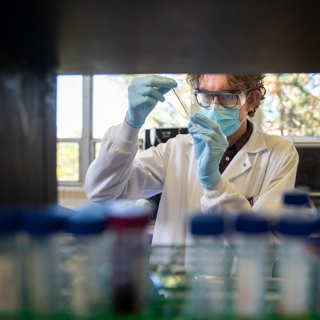People
David Shepherd
Professor
Contact
- Office
- SB 284
- Phone
- (406) 243-2224
- david.shepherd@umontana.edu
- Curriculum Vitae
- View/Download CV
Personal Summary
After completing undergraduate work in Molecular Biology at Florida Institute of Technology, Dave Shepherd was trained as a cellular immunologist in the laboratory of Dr. Randolph J. Noelle at Dartmouth Medical School. He earned his Ph.D. in Toxicology at Oregon State University under the supervision of Dr. Nancy I. Kerkvliet. Following postdoctoral training in Molecular Toxicology with Dr. Mark Leid at OSU, he joined the faculty in the Department of Biomedical and Pharmaceutical Sciences at the University of Montana in 2002.
Education
Florida Institute of Technology, B.S., Molecular Biology
Oregon State University, Ph.D., Toxicology
Courses Taught
- PHAR 324, Medicinal Plants
- PHAR 445, Immunopharmacology
- PHAR 342, Physiological Systems II
- PHAR 444, Pharmacology/Toxicology II
- BMED 644, Immunotoxicology
Research Interests
Field of Study
Many chemicals are known or suspected to cause deleterious effects on human health. Studies of pharmaceuticals and environmental contaminants indicate that the toxicity of many chemicals is mediated by a mechanism that involves or affects the immune system. Broadly speaking, chemicals can cause two different types of immune dysfunction: immune suppression, leading to an increased susceptibility to infectious diseases and cancer; and immune enhancement, leading to either autoimmune disease or allergy. While many studies indicate that exposure of humans and laboratory animals to chemicals can induce immune disorders, the mechanisms by which they alter immune function are largely unknown.
Dr. Shepherd's research program currently encompasses two somewhat distinct areas of immunology. The first focus of his laboratory centers on defining the role of the man-made environmental chemicals such as dioxins and PCBs on dendritic cells (DCs), which are considered to be the "professional" antigen presenting cells in the immune system. His research is aimed at elucidating the mechanisms of immune suppression by these toxicants by addressing the role of Aryl hydrocarbon receptor (AhR) activation in DCs and the functional consequences of these alterations. The second area of investigation by this research group aims to develop new immunotherapeutics. Specifically, two novel platforms are being developed that intentionally modulate the AhR: (1) combining AhR agonists and DC-specific antibodies in liposomal nanoparticles to generate targeted immunosuppression, and (2) targeting both DCs and CD4+ T cells with AhR antagonist-loaded nanoparticles to block pollutant-induced immunotoxicity. These studies utilize both in vitro and in vivo models of innate and adaptive immunity.
Selected Publications
J.M. Kreitinger, S. Navarro, J. Bankoti, S.A. Wetzel, C.A. Beamer, T. Simones and D.M. SHEPHERD. (201X). TCDD suppresses antigen-specific in vivo interactions between OT-II CD4+ T cells and OVA- loaded dendritic cells. (manuscript in revision).
S. Kado, W.L. Chang, A.N. Chi, C. Campbell, M. Wolny, D.M. SHEPHERD, and C.F. Vogel. (2017). Aryl hydrocarbon receptor signaling modifies Toll-like receptor-regulated responses in human dendritic cells. 91: 2209-2221.
R.J. Noelle, M. Roy, D.M. SHEPHERD, I. Stamenkovic, J.A. Ledbetter, and A. Aruffo. (2016). Pillars Article: A 39-kDa protein on activated helper T cells binds CD40 and transduces the signal for cognate activation of B cells. (Proc. Natl. Acad. Sci. U.S.A. 89: 6550-6554). J Immunol., 197: 4185-4190.
J.M. Kreitinger, C.A. Beamer and D.M. SHEPHERD. (2016). Environmental Immunology: Lessons learned from exposure to a select panel of immunotoxicants. (Invited review). J Immunol., 196: 3217-3225.
G.L. Beamer, B.P. Seaver, F. Jessop, D.M. SHEPHERD, and C.A. Beamer. (2016). Crystalline silica
modifies detection of microbial ligands through altered expression of pattern recognition receptors on macrophages. Frontiers in Immunology, 7:49: 1-11.
L.E. Thueson, T.R. Emmons, D.L. Browning, J.M. Kreitinger, D.M. SHEPHERD and S.A. Wetzel. (2015). In vitro exposure to the herbicide atrazine inhibits T cell activation, proliferation, and cytokine production and significantly increases the frequency of Foxp3+ regulatory T cells. Toxicol. Sci., 143: 418-429.
C.A. Beamer and D.M. SHEPHERD. (2013). Role of the aryl hydrocarbon receptor (AhR) in lung inflammation. (Invited review). Semin. Immunopathol., 35: 693-704.
J.M. Benson, C.A. Beamer, B.P. Seaver and D.M. SHEPHERD. (2012). Indole-3-carbinol exerts sex-specific effects in murine colitis. European J Inflamm., 10: 335-346.
C.A. Beamer, B.P. Seaver, and D.M. SHEPHERD. (2012). The Aryl hydrocarbon receptor (AhR) regulates silica-induced inflammation, but not fibrosis. Toxicol. Sci., 126: 554-568.
C.A. Beamer and D.M. SHEPHERD. (2012). Inhibition of TLR ligand- and interferon-γ-induced murine microglial activation by Panax notoginseng. J. Neuroimmune Pharmacol., 7: 465-476.
J.M. Benson and D.M. SHEPHERD. (2011). Dietary ligands of the aryl hydrocarbon receptor induce anti- inflammatory and immunoregulatory effects on murine dendritic cells. Toxicol. Sci., 124: 327- 338.
J.M. Benson and D.M. SHEPHERD. (2011). Aryl hydrocarbon receptor activation by TCDD reduces inflammation associated with Crohn’s disease. Toxicol. Sci., 120: 68-78.
T. Simones and D.M. SHEPHERD. (2011). Consequences of AhR activation in steady-state dendritic cells. Toxicol. Sci., 119: 293-307.
A.K. Miller, J.M. Benson, D.N. Muanza, J.R. Smith and D.M. SHEPHERD. (2011). Anti-inflammatory effects of natural product formulations on murine dendritic cells. Journal of Dietary Suppl., 8: 19-33.
J.M. Benson, A.K. Miller, N. Cooper, D.N. Muanza, J.R. Smith, D.M. SHEPHERD. (2010). Anti-inflammatory effects of natural product formulations on murine macrophages. Journal of Dietary Suppl., 7: 227-239.
J. Bankoti, B. Rase, T. Simones and D.M. SHEPHERD. (2010). Functional and phenotypic effects of AhR activation in inflammatory dendritic cells. Toxicol. Appl. Pharm., 246: 18-28.
J. Bankoti, A. Burnett, S. Navarro, A.K. Miller, B. Rase and D.M. SHEPHERD. (2010). Effects of TCDD on the fate of naïve dendritic cells. Toxicol. Sci., 115: 422-434.
J.M. Benson, A.J. Pokorny, A.G. Rhule, C.A. Wenner, N.B. Cech, V. Kandhi and D.M. SHEPHERD. (2010). Echinacea Purpurea extracts modulate murine dendritic cell fate and function. Food Chem Toxicol., 48: 1170-1177.
A.G. Rhule, B. Rase, J.R. Smith, and D.M. SHEPHERD. (2008).Toll-like receptor ligand-induced activation of murine DC2.4 cells is attenuated by Panax Notoginseng. J. Ethnopharm., 116: 179-186.
A.G. Rhule, S. Navarro, J.R. Smith, and D.M. SHEPHERD. (2006). Notoginseng Attenuates LPS-Induced Pro-Inflammatory Mediators in RAW264.7 cells. J. Ethnopharm 106: 121-128.
M. Leid, J.E. Ishmael, D.A. Avram, D. SHEPHERD, V. Fraulob, and P. Dolle. (2004). CTIP1 and CTIP2 are differentially expressed during mouse embryogenesis. Gene Exp Patterns 4: 733-739.
C.J. Funatake, E.A. Dearstyne, L.B. Steppan, D.M. SHEPHERD, E.S. Spanjaard, A. Marshak-Rothstein, and N.I. Kerkvliet. (2004). Early consequences of 2,3,7,8-Tetrachlorodibenzo-p-dioxin exposure on the activation and survival of antigen-specific T cells. Toxicol. Sci. 82: 129-142.
T. Senawong, V.J. Peterson, D. Avram, D.M. SHEPHERD, R.A. Frye, S. Minucci, and M. Leid (2003). Involvement of the histone deacetylase SIRT1 in chicken ovalbumin upstream promoter transcription factor (COUP-TF)-interacting protein 2-mediated transcriptional repression. J. Biol. Chem. 278: 43041-43050.
N.I. Kerkvliet, D.M. SHEPHERD, and L. Baecher-Steppan. (2002). T lymphocytes are direct, aryl hydrocarbon receptor (AhR)-dependent targets of 2,3,7,8-tetrachlorodibenzo-p-dioxin (TCDD): AhR expression in both CD4+ and CD8+ T cells is necessary for full suppression of a cytotoxic T lymphocyte response by TCDD. Toxicol. Appl. Pharmacol. 185: 146-152.
D.M. SHEPHERD, L.B. Steppan, O.R. Hedstrom, and N.I. Kerkvliet. (2001). Anti-CD40 treatment of 2,3,7,8-tetrachlorodibenzo-p-dioxin (TCDD)-exposed C57Bl/6 mice induces activation of antigen presenting cells yet fails to overcome TCDD-induced suppression of allograft immunity. Toxicol. Appl. Pharmacol. 170: 10-22.
D.M. SHEPHERD, E.A. Dearstyne, and N.I. Kerkvliet. (2000). The effects of TCDD on the activation of ovalbumin (OVA)-specific DO11.10 transgenic CD4+T cells in adoptively transferred mice. Toxicol. Sci. 56: 340-350.
D.M. SHEPHERD and N.I. Kerkvliet. (1999). Disruption of CD154:CD40 blocks generation of allograft immunity without affecting APC activation. J. Immunol. 163: 2470-2477.
N.I. Kerkvliet, L. Baecher-Steppan, D.M. SHEPHERD, J.A. Oughton, B.A. Vorderstrasse, and G.D. DeKrey. (1996). Inhibition of TC-1 cytokine production, effector cytotoxic T lymphocyte development and alloantibody production by 2,3,7,8-tetrachlorodibenzo-p-dioxin. J. Immunol. 157: 2310-2319.
L.M. Marshall, D.M. SHEPHERD, J.A. Ledbetter, A. Aruffo, and R.J. Noelle. (1994). Signalling events during helper T cell-dependent B cell activation. I. Analysis of the signal transduction pathways triggered by activated helper T cell in resting B cells. J. Immunol. 152: 4816-4825.
A.J. Van den Eertwegh, R.J. Noelle, M. Roy, D.M. SHEPHERD, A. Aruffo, J.A. Ledbetter, W.M. Boersma, and E. Claassen. (1993). In vivo CD40-gp39 interactions are essential for thymus-dependent humoral immunity. I. In vivo expression of CD40 ligand, cytokines, and antibody production delineates sites of cognate T-B cell interactions. J. Exp. Med. 178: 1555-1565.
T.M. Foy, D.M. SHEPHERD, F.H. Durie, A. Aruffo, J.A. Ledbetter, and R.J. Noelle. (1993). In vivo CD40-gp39 interactions are essential for thymus-dependent humoral immunity. II. Prolonged suppression of the humoral immune response by an antibody to the ligand for CD40, gp39. J. Exp. Med. 178: 1567-1575.
J.R. Daum, D.M. SHEPHERD, and R.J. Noelle. (1993). Immunotoxicology of cadmium and mercury on B lymphocytes-- I. Effects on lymphocyte function. Int. J. Immunopharmacol. 15: 383-394.
R.J. Noelle, L.M. Marshall, M. Roy, D.M. SHEPHERD, I. Stamenkovic, J.A. Ledbetter, A. Aruffo, and H.P. Fell. (1992). Role of contact and soluble factors in the growth and differentiation of B cells by helper T cells. Adv. Exp. Med. Biol. 323: 131-138.
R.J. Noelle, D.M. SHEPHERD, and H.P. Fell. (1992). Cognate interaction between T helper cells and B cells. VII. Role of contact and lymphokines in the expression of germline and mature gamma 1 transcripts. J. Immunol. 149: 1164-1169.
R.J. Noelle, M. Roy, D.M. SHEPHERD, I. Stamenkovic, J.A. Ledbetter, and A. Aruffo. (1992). A 39-kDa protein on activated helper T cells binds CD40 and transduces the signal for cognate activation of B cells. Proc. Natl. Acad. Sci. U.S.A. 89: 6550-6554.
R.J. Noelle, J.R. Daum, W.C. Bartlett, J. McCann, and D.M. SHEPHERD. (1991). Cognate interactions between helper T cells and B cells. V. Reconstitution of T helper cell function using purified plasma membranes from activated Th1 and Th2 T helper cells and lymphokines. J. Immunol. 146: 1118-1124.
D.M. SHEPHERD and R.J. Noelle. (1991). The lack of memory B cells in immune bone marrow. Transplantation 52: 97-100.
W.C. Bartlett, J. McCann, D.M. SHEPHERD, M. Roy, and R.J. Noelle. (1990). Cognate interactions between helper T cells and B cells. IV. Requirements for the expression of effector phase activity by helper T cells. J. Immunol. 145: 3956-3962.
Affiliations
CMMB Graduate Program, Division of Biological Sciences
Honors / Awards
2001 Paper of the year (Toxicological Sciences), Immunotoxicology Specialty Section, SOT
2006 Junior Faculty Award, American Association of Immunologists
2007 PACE External Mentor Award
2008, 2012, 2013 Teacher of the Month (UM Pharmacy program)
2009 Outstanding Young Investigator Award, Immunotoxicology Specialty Section, SOT
2012-2013 International Faculty Exchange Award & hort-Term Academic Enrichment Award, University of Montana
(Malaghan Institute of Medical Research; Wellington, New Zealand; 10/19/12-4/14/13)
2015-2019 Appointed to III Study Section, NIH/CSR

